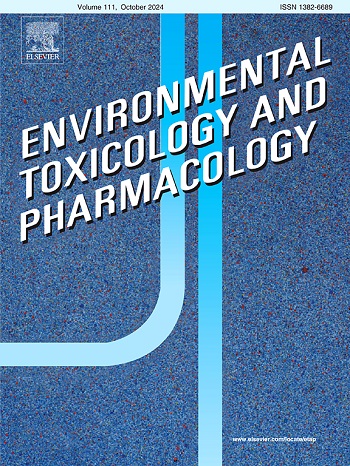Engraftment after pediatric hematopoietic stem cell transplantation and its association with recipient and donor phthalate and bisphenol A exposure levels: A cohort study
IF 4.2
3区 环境科学与生态学
Q2 ENVIRONMENTAL SCIENCES
引用次数: 0
Abstract
Phthalates and bisphenols, ubiquitous compounds found in various everyday products, have garnered attention due to their potential health-disrupting effects. This study aimed to (1) investigate urinary phthalate metabolites and bisphenol A (BPA) levels in donors and recipients prior to allogeneic hematopoietic stem cell transplantation (HSCT) and monitor changes in these compounds in pediatric recipients at different time points (day-9, day 0, day+7, day+28, day+90), and (2) assess their association with engraftment success. Urine samples from pediatric recipients and donors were collected for analysis of phthalate metabolites and BPA in 34 donor-recipient pairs. Monomethyl phthalate metabolite was not detectable in any of the urine samples. A notable increase in phthalate metabolites and BPA levels was observed in recipients starting from day+28. Granulocyte engraftment time showed a positive correlation with donor urinary levels of mono-n-butyl phthalate (MBP), mono-2-ethylhexyl phthalate (MEHP), and monobenzyl phthalate metabolites with recipient MBP levels measured on day-9. Moreover, donor urinary MBP and MEHP levels were also linked to delayed platelet engraftment. No relationship was observed between engraftment timing and the urine levels of monoethyl phthalate metabolite or BPA in donor-recipient pairs. In cases of mucositis, MEHP and MEP levels on day 0 were higher compared to the non-mucositis group. No relationship was identified between hemorrhagic cystitis and the levels of urine phthalate metabolites or BPA. These findings highlight the potential role of plasticizer exposure in influencing engraftment outcomes, although no significant associations were found between MEP or BPA levels and engraftment.
儿童造血干细胞移植后的植入及其与受体和供体邻苯二甲酸盐和双酚A暴露水平的关系:一项队列研究。
邻苯二甲酸酯和双酚是各种日常用品中普遍存在的化合物,由于它们潜在的破坏健康的影响而引起了人们的关注。本研究旨在(1)研究同种异体造血干细胞移植(HSCT)前供体和受者尿邻苯二甲酸盐代谢物和双酚A (BPA)水平,并监测这些化合物在不同时间点(第9天、第0天、第7天、第28天、第90天)的变化,以及(2)评估它们与移植成功的关系。收集儿童受体和供体的尿液样本,分析34对供体-受体的邻苯二甲酸酯代谢物和BPA。所有尿样均未检出邻苯二甲酸一甲基代谢物。从第28天开始,受体中邻苯二甲酸酯代谢物和BPA水平显著增加。粒细胞植入时间与供体尿液中邻苯二甲酸单正丁酯(MBP)、邻苯二甲酸单2-乙基己酯(MEHP)和邻苯二甲酸单苯代谢物水平与受体第9天测量的MBP水平呈正相关。此外,供体尿MBP和MEHP水平也与血小板植入延迟有关。在供体-受体配对中,植入时间与尿液中邻苯二甲酸一乙酯代谢物或BPA水平没有关系。在粘膜炎病例中,与非粘膜炎组相比,第0天MEHP和MEP水平较高。出血性膀胱炎与尿中邻苯二甲酸代谢物或双酚a的水平之间没有关系。这些发现强调了塑化剂暴露在影响植入结果中的潜在作用,尽管没有发现MEP或BPA水平与植入之间的显著关联。
本文章由计算机程序翻译,如有差异,请以英文原文为准。
求助全文
约1分钟内获得全文
求助全文
来源期刊
CiteScore
7.00
自引率
4.70%
发文量
185
审稿时长
34 days
期刊介绍:
Environmental Toxicology and Pharmacology publishes the results of studies concerning toxic and pharmacological effects of (human and veterinary) drugs and of environmental contaminants in animals and man.
Areas of special interest are: molecular mechanisms of toxicity, biotransformation and toxicokinetics (including toxicokinetic modelling), molecular, biochemical and physiological mechanisms explaining differences in sensitivity between species and individuals, the characterisation of pathophysiological models and mechanisms involved in the development of effects and the identification of biological markers that can be used to study exposure and effects in man and animals.
In addition to full length papers, short communications, full-length reviews and mini-reviews, Environmental Toxicology and Pharmacology will publish in depth assessments of special problem areas. The latter publications may exceed the length of a full length paper three to fourfold. A basic requirement is that the assessments are made under the auspices of international groups of leading experts in the fields concerned. The information examined may either consist of data that were already published, or of new data that were obtained within the framework of collaborative research programmes. Provision is also made for the acceptance of minireviews on (classes of) compounds, toxicities or mechanisms, debating recent advances in rapidly developing fields that fall within the scope of the journal.

 求助内容:
求助内容: 应助结果提醒方式:
应助结果提醒方式:


